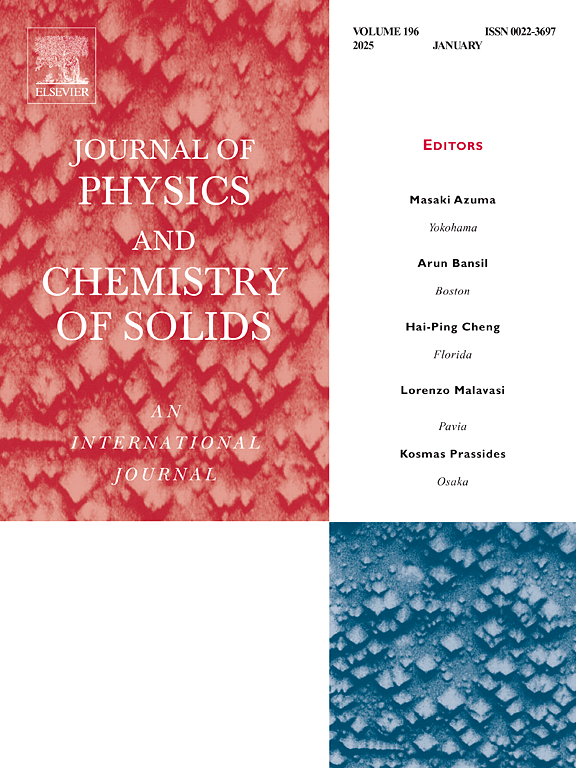First-principles investigation of ACrxTi(1-x)O3 (A = La, Nd; x = 0.25,0.5,0.75) intermetallics for energy storage applications
IF 4.3
3区 材料科学
Q2 CHEMISTRY, MULTIDISCIPLINARY
引用次数: 0
Abstract
The Full-Potential (FP) Linearized augmented plane-wave (LAPW) approach under density functional theory (DFT) has been used to analyze the optimized structural stability, electrical, optical, thermal, and thermoelectric belongings of the Ti-doped LaCrO3 and NdCrO3. The calculations for ACrxTi(1-x) O3 (A = La, Nd) (x = 0,0.25,0.5,0.75,1) were carried out using the wien2k software. By forming a supercell, the structure of this compound and the suggested combinations are obtained. In the Brillouin zone, 1000 k-points are used for performing the calculation. It is assumed that the plane wave expansion (RMT∗KMAX) is 7. When doping Ti to the LaCrO3 and NdCrO3 materials, a phase transition from cubic to tetragonal occurs. The compound's highest optical conductivity, reflectivity, and absorption coefficient are found in the visible, ultraviolet, and infrared light regions that are applicable to solar cell materials. The computed band structure indicates that the material is a conductor. Since the NdCrO3 compound's power factor is higher than that of other compounds, it can produce more power which is helpful in battery energy storage systems. NdCrO3 has a high zT value, making it appropriate for use in thermoelectric devices. NdCr0.5Ti0.5O3 is superior to all other compounds when it comes to energy storage applications.
ACrxTi(1-x)O3 (A = La, Nd)的第一性原理研究X = 0.25,0.5,0.75)用于储能应用的金属间化合物
利用密度泛函理论(DFT)下的全势(FP)线性化增广平面波(LAPW)方法分析了ti掺杂LaCrO3和NdCrO3的优化结构稳定性、电学、光学、热学和热电性能。ACrxTi(1-x) O3 (A = La, Nd) (x = 0,0.25,0.5,0.75,1)的计算采用wien2k软件进行。通过形成超级单体,得到了该化合物的结构和建议的组合。在布里渊区,使用1000个k点进行计算。假设平面波展开(RMT * KMAX)为7。在LaCrO3和NdCrO3材料中掺杂Ti后,发生了由立方相到四方相的相变。该化合物的最高的光学导电性、反射率和吸收系数是在可见光、紫外光和红外光区域发现的,适用于太阳能电池材料。计算出的能带结构表明该材料是导体。由于NdCrO3化合物的功率因数高于其他化合物,因此可以产生更多的功率,这有助于电池储能系统。NdCrO3具有很高的zT值,使其适合用于热电器件。在储能应用方面,NdCr0.5Ti0.5O3优于所有其他化合物。
本文章由计算机程序翻译,如有差异,请以英文原文为准。
求助全文
约1分钟内获得全文
求助全文
来源期刊
CiteScore
7.80
自引率
2.50%
发文量
605
审稿时长
40 days
期刊介绍:
The Journal of Physics and Chemistry of Solids is a well-established international medium for publication of archival research in condensed matter and materials sciences. Areas of interest broadly include experimental and theoretical research on electronic, magnetic, spectroscopic and structural properties as well as the statistical mechanics and thermodynamics of materials. The focus is on gaining physical and chemical insight into the properties and potential applications of condensed matter systems.
Within the broad scope of the journal, beyond regular contributions, the editors have identified submissions in the following areas of physics and chemistry of solids to be of special current interest to the journal:
Low-dimensional systems
Exotic states of quantum electron matter including topological phases
Energy conversion and storage
Interfaces, nanoparticles and catalysts.

 求助内容:
求助内容: 应助结果提醒方式:
应助结果提醒方式:


